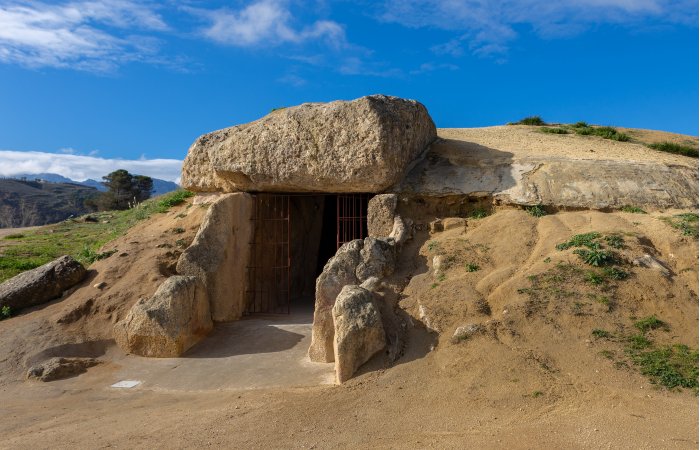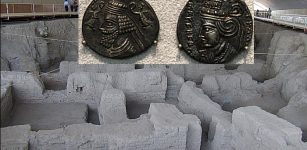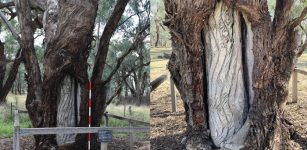Why Is The Mysterious Menga Dolmen One Of The Greatest Neolithic Engineering Achievements?
Conny Waters - AncientPages.com - Scientists have long been intrigued by the mysterious Menga Dolmen in Spain. The Menga Dolmen is one of the largest known ancient megalithic structures on the European continent.
Located in the Piedras Blancas site, Antequera, Málaga the Dolmen of Menga dates back to the Neolithic Age. Based on previous studies, scientists conclude the Menga Dolmen "is a megalithic burial mound called a tumulus, a long barrow form of a dolmen with the entrance made up of an enormous trilith that dates back to approximately 3750-3650 B.C.
The Dolmen de Menga is in the Spanish town of Antequera (Malaga). Credit: Adobe Stock - Eduardo Estellez
This monument, together with the Matacabras shelter and its cave paintings, would have formed a sacred space for the Neolithic communities of the region before the great Menga dolmen was built.
It is 27.5 meters (90 ft) long, 6 meters (20 ft) wide and 3.5 meters (11 ft) high, and was built with thirty-two megaliths, of which the largest weighing about 180 tonnes (200 tons). The whole construction is covered with a tumulus of 50 m in diameter." 1
In a recent study, scientists re-investigated the construction of the massive Menga Dolmen and said it is one of the greatest Neolithic engineering achievements of all time.
"The technical and intellectual capabilities of past societies are reflected in the monuments they were able to build. Tracking the provenance of the stones utilised to build prehistoric megalithic monuments, through geological studies, is of utmost interest for interpreting ancient architectures as well as to contribute to their protection. According to the scarce information available, most stones used in European prehistoric megaliths originate from locations near the construction sites, which would have made transport easier.
The Menga dolmen (Antequera, Malaga, Spain), listed in UNESCO World Heritage since July 2016, was designed and built with stones weighting up to nearly 150 tons, thus becoming the most colossal stone monument built in its time in Europe (c. 3800–3600 BC)," the research team write in their study published in Nature.
The Menga Dolmen was built into the top of a hill using large stones, the largest of which weigh more than 100 tons. Scientists decided to find out how Neolithic people found these heavy stones and how they transported them.
Using petrographic and stratigraphic analysis techniques, the researchers discovered most of the stones were calcarenites, "a poorly cemented detrital sedimentary rock comparable to those known as 'soft stones' in modern civil engineering. They were quarried from a rocky outcrop located at a distance of approximately 1 km." Considering how fragile calcarenites are it must have been difficult to transport these stones without causing damage. "The use of soft stone in Menga reveals the human application of new wood and stone technologies enabling the construction of a monument of unprecedented magnitude and complexity," the researchers state.
Moving and planning such gigantic stones "from Cerro de la Cruz to the hill of Menga must have demanded intensive planning, highly accurate logistics and enormous labor investments." 2 Placing a rock that weighs approximately 150 tons on the top of the chamber to serve as a roof required engineering skills.
(a) Geological map of tectonic jointing on DTM, showing the location of Menga and Viera and the likely quarrying areas at Cerro de la Cruz. (b) Stereographic representation of the groups of joints. (c) Overview of the tectonic fracturing present in quarry areas #2 and #3. (d) Groups of joints observed in Quarry #1. (e) Example of a possible discarded megalithic stone at Quarry #1. Credit: Scientific Reports (2023). DOI: 10.1038/s41598-023-47423-y
"Neolithic communities display a deep knowledge of the geotechnical and geological properties of the stones used and the quality of the terrain chosen as foundation. They avoided marls, clays and unconsolidated lithologies for stone movement and monument emplacement. They carefully selected the substrate, used pillars and avoided water infiltration, among others, in order to prevent deterioration of these soft stones and ensure the stability of the dolmen. For this purpose, a waterproof tumulus was created." 2
See also: More Archaeology News
In addition, "the woodwork associated with the construction process must have also demanded the use of large amounts of timber. Considering the ramp construction and the size, number (over 30 large stones) and fragility of the stones, the construction of Menga embodies a unique accomplishment representing the state-of-the-art in megalithic engineering in prehistoric Iberia and possibly in Europe.
Interior of the dolmen, looking outwards. Credit: Pedro J Pacheco - CC BY-SA 4.0
Menga stone C-5 emphasizes the magnitude of this achievement as it is the largest stone used in a composite megalithic monument and it is also a soft stone used as a cover slab which requires a high level of technical proficiency." 2
The Menga Dolmen in Spain is a testimony to the advanced engineering knowledge of Neolithic people. The construction of the huge megalith required planning, hard work, and engineering skills.
Written by Conny Waters - AncientPages.com Staff Writer
Expand for references






















